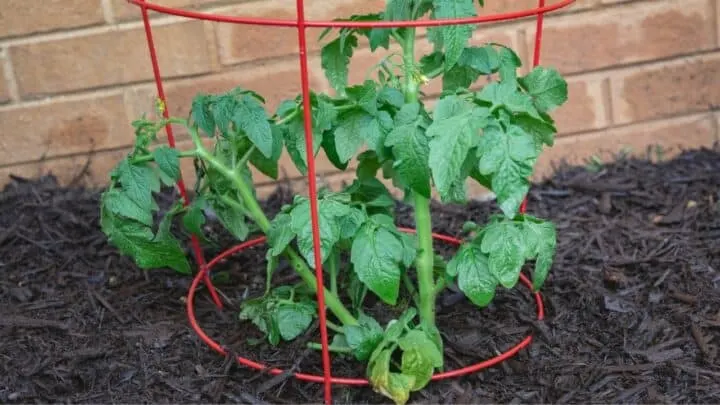How do you use tomato cages? Tomatoes get heavy once they bear fruits and need to be supported.
You could have broken plants and poor production if you fail to cage your tomatoes.
Supporting your plants with a cage will help keep them standing tall and offers protection from the wind. A plant has the strength to stand on its own until it is covered with gorgeous, ripe tomatoes.
Cages for your tomatoes can be round, square, pyramids, store-bought, or homemade.
The cages must be sturdy enough to support the tomato plants growing weight.
Whether a new gardener or an old hand, follow along about how to use tomato cages to protect your plants. I was struggling with this in the beginning as well. I didn’t know when and how to use them properly.
Table of Contents
How To Use Tomato Cages
Set your tomato cages in the garden once your seedlings are ready for planting. Then, center the cage around the tomato, pressing it firmly if it has legs. You can also use stakes or wire pins to anchor the cage to the ground. As the tomato plants grow, direct their branches and tie them to the cage to keep them in place.
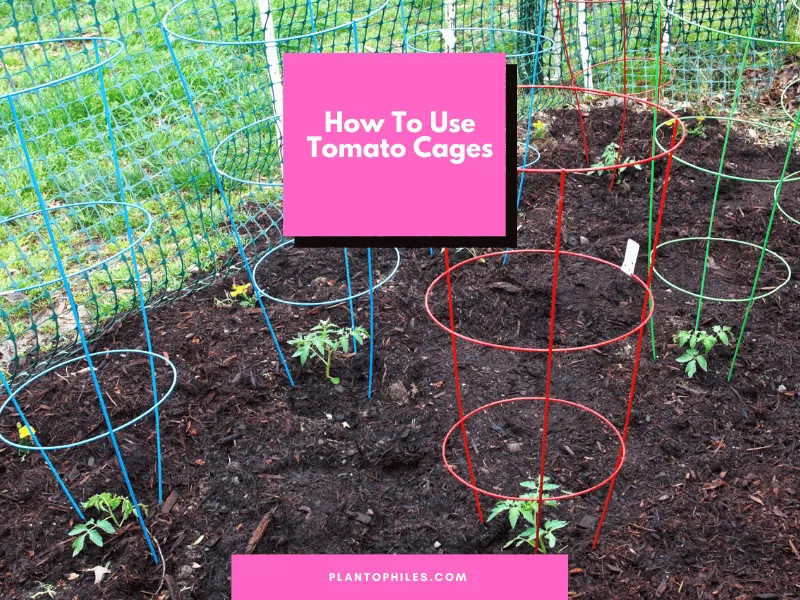
A Guide To Using Tomato Cages The Right Way
1. Plant your seedlings in the garden or raised bed
No matter what type of tomato cage you have, there are general steps that you’ll need to observe to use them properly.
Technically, when your tomato seedlings are ready to plant, set them out in your garden.
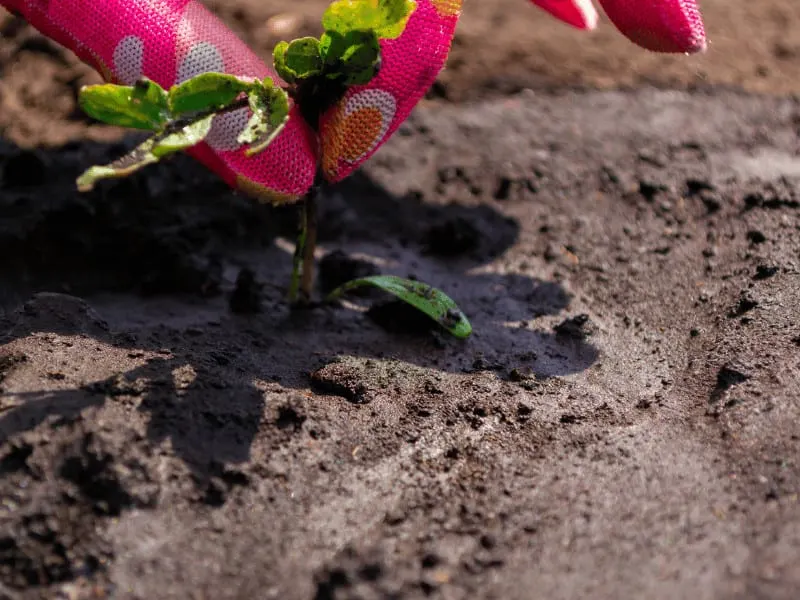
2. Press the cage into the soil around your plant
Next, center the cage around your plant and firmly press it into the soil, if you have the type of cage with legs.
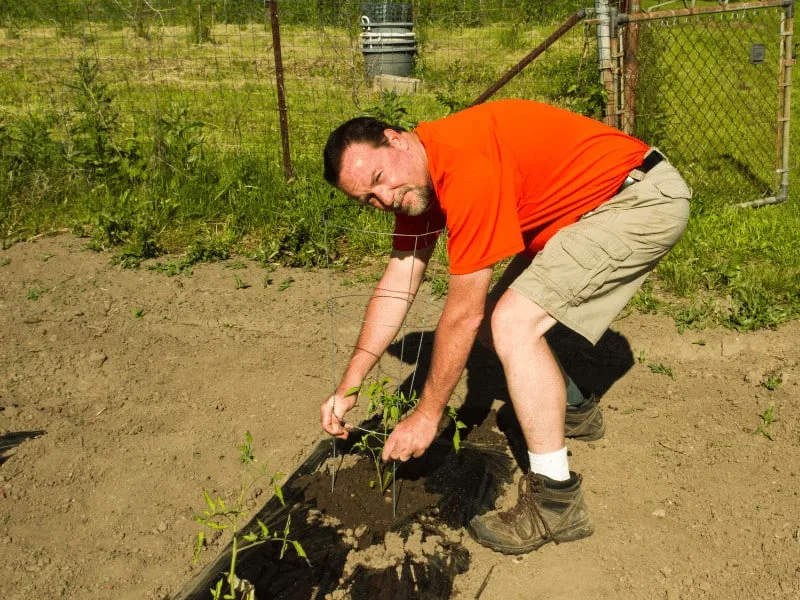
3. Secure the cage if it doesn’t have legs
For other cages, secure them to the ground with stakes or wire pins.
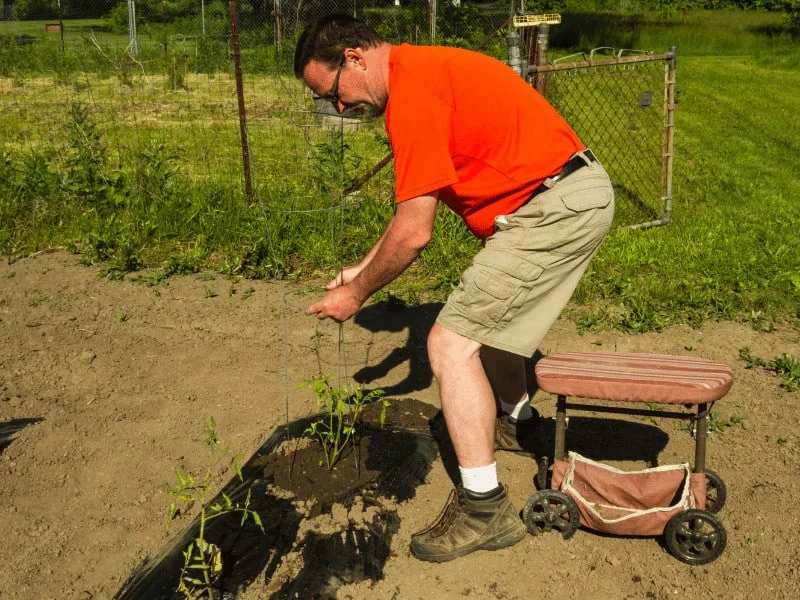
4. Direct the branches once your tomato plant grows tall
Once the tomato plant begins to fill the tomato cage, you will need to direct the branches on which way to grow.
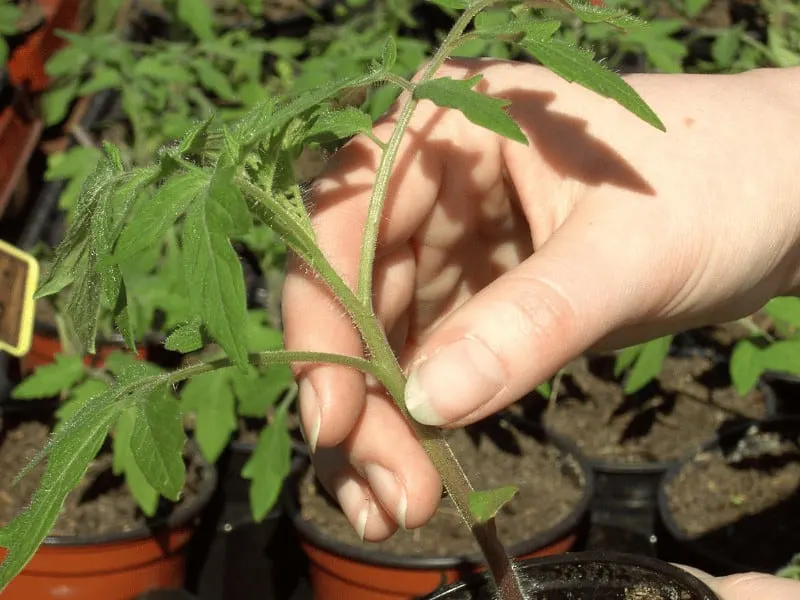
5. Tie the branches to the cage
As your plant gets bigger and bigger, you can tie the branches to the cage to keep them in place.
Have the tomato cages ready to add when you set your tomato plants out. By doing so, the roots will grow around the part you have stuck in the ground.
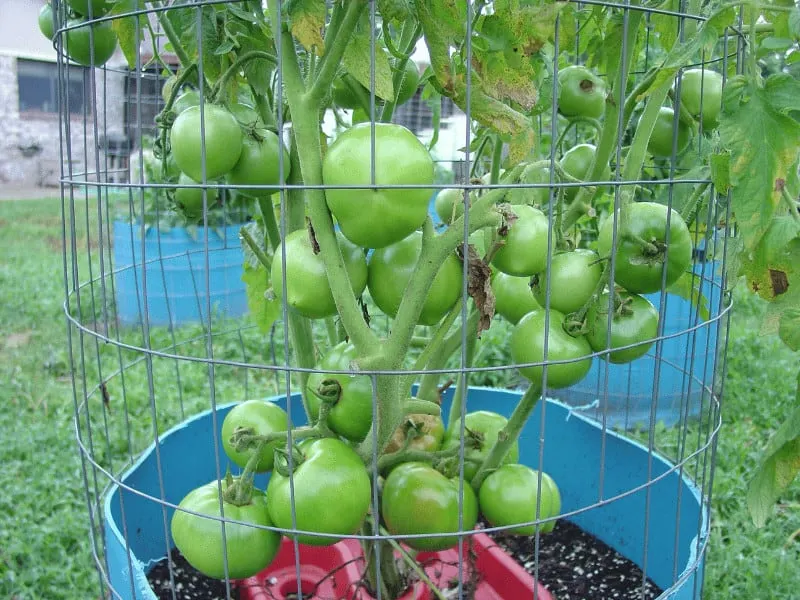
Tomato Cages And Their Benefits
1. Offers Support
As your tomato plant grows and begins to set fruit, the weight can drag the branches to the ground if unsupported.
Tomatoes near the soil get dirty and attract pests, fungi, and bacteria.
By putting a cage around your plant, you offer it support from wind, rain, and its weight. You can press into the ground most round tomato cages that have three legs.
The legs provide the cage more support than if it sat straight on the ground.
So, when placing your cages, be sure they are firmly set to offer the most support to your plants.
For example, if you make your cages from four-by-four, wire fencing, or other material, be sure you stake them to the ground to keep them stable.
2. Promote Healthy Tomato Plants
Many disorders can occur in a growing tomato plant. For example, they can get blight, fungus, mildew, or insect infestations.
A tomato cage will help you keep your plant off the ground, which will help keep it from getting too wet and dirty.
When tying branches to the cage, you can use zip ties, soft pieces of cloth, or anything else you might have. Tie the branches loosely and give them room to move and grow.
As your plant grows, keep an eye on the areas you have tied to be sure they are not chafing.
You also need to check where you have tied the plant to ensure the tie is not too tight as the plant grows.
3. More Fruit Production
Healthy plants produce more fruit; a tomato cage will help you keep them healthier. The cage gives you easy access to the plant for pruning and inspection.
If you can keep your tomato plant from becoming a matted mess, it will have more room to produce lovely fruit.
An unattended, uncaged plant will not be as healthy as its caged counterpart as long as you tend it.
A cage does not take all the work out of keeping tomato plants healthy and producing fruit, but it makes it a little easier.
To Cage Or Not To Cage
Caging is the best method of supporting your tomatoes if you are growing a few plants. However, if you are growing a row of plants, staking will take less time and be less costly.
When planting vining tomatoes, you can use a cage or stakes to support the plant while it is growing.
However, it will outgrow the cage at some point, and you will need to give the plant a trellis for support.
Whether you are growing bush or vine tomatoes, you need to offer them physical support to reach their potential.
When combined with the proper soil mixture and location, watering, and fertilizer, a tomato cage will help you grow a bountiful crop.
Different Kinds Of Tomatoes
Determinate tomatoes are bush variety tomatoes and can get three to four feet high.
They do very well when grown in a cage and have an average height of about three feet, depending on the variety.
They require a cage about four to five feet tall because some cages must be stuck in the ground to keep them stable.
Use a shorter cage if you are growing a variety of tomatoes that do not get as tall.
Indeterminate tomatoes, also called vining tomatoes, can be started with a tomato cage.
However, you will need to add more structure for its growth, as it can grow 12 to 15 in length and need something to climb.
Bush tomatoes grow to a determined height (determinate), whereas vine tomatoes do not (indeterminate). Both varieties need support as they grow, and you can use a cage when growing vine tomatoes.
Be ready to offer more support than the cage because that plant will burst from the top and seek higher ground.
Frequently Asked Questions About How To Use Tomato Cages
Can I make my tomato cages?
Cages are inexpensive, but if you have fence wire lying about, it can be easily formed into a circular cage for your tomato plants. Bamboo is also a good material for tomato cages and is an easily renewed source.
Will stakes work as well as a tomato cage?
They can, and there are applications where stakes work better. When using stakes instead of tomato cages, set your stakes when you place your plant in the ground. Staking your plants early will keep them from disturbing the roots after they develop.
Can I grow tomatoes without a tomato cage?
You can grow tomatoes without cages or any support. Changes are that they will bend and might break. Other issues can be diseases from leave touching the ground. There are also other options, such as stakes.
What size tomato cage do I need?
Get a tomato cage of 15-20 inches (38-51 cm) for smaller varieties such as Cherry tomatoes and Roma tomatoes. For larger tomato varieties, such as heirloom and beef tomatoes, you will need a cage of 70 inches (178cm+) and more.
Takeaways
To use a tomato cage:
- Plant your seedlings in the garden or raised bed
- Press the cage into the soil around your plant
- Secure the cage if it doesn’t have legs
- Direct the branches once your tomato plant grows tall
- Tie the branches to the cage

Daniel has been a plant enthusiast for over 20 years. He owns hundreds of houseplants and prepares for the chili growing seasons yearly with great anticipation. His favorite plants are plant species in the Araceae family, such as Monstera, Philodendron, and Anthurium. He also loves gardening and is growing hot peppers, tomatoes, and many more vegetables.

